![]()
Thu, May 19, 2011 | The Meir Amit Intelligence and Terrorism Information Center

Brainwashing the younger generation with the "right of return:" Gazan children carrying signs reading "We will certainly return to…Acre" and "We will certainly return to…Ashdod." The key at the lower right symbolizes the so-called "right or return;" upper left, the Hamas emblem (Hamas’ Palestine-info website, May 15, 2011).
Nakba Day: “Right of Return” is Central to Palestinian’ Strategy to Liberate “Palestine”
The main theme of the various Nakba Day events was the Palestinian refugees’ return to the 1948 territories and the destruction of the State of Israel. Clinging to the refugees’ return is central to Hamas’ strategy, backed by Iran and Hezbollah and supported by Palestinians in the territories and abroad.
Overview
Events for Nakba Day, the 63rd anniversary of the founding of the State of Israel in 1948, climaxed on May 15, 2011. They included mass marches, rallies and propaganda demonstrations. In some locations there were also riots, stone-throwing, confrontations with IDF soldiers and a violent invasion of Israeli territory.
In most cases the authorities (or local powers) contained the events and kept them under control. In the Druze village of Majdal Shams in the northern Golan Heights, however, the Syrians enabled (and even encouraged) a mob to approach the border fence, where rioters broke through and invaded Israeli territory. Most of them returned to Syria after making their presence felt in Majdal Shams, where they shouted slogans for the “right of return” to Palestine. The violent confrontation between them and IDF soldiers resulted in four dead rioters and several wounded IDF soldiers and rioters.
The most prominent theme expressed by speakers from Hamas, Fatah and the individual participants of regional and foreign demonstrations was the full realization of the Palestinian refugees’ so-called “right of return” to the State of Israel, to the places they abandoned or were expelled from in 1948. The “right” was described as “sacred,” and no one had the authority to deny or partially modify it, or to agree to settling the refugees in Arab countries. The various speeches, slogans and placards held by demonstrators stressed that the return of the refugees involved jihad to “liberate Palestine from the [Mediterranean] sea to the [Jordan] river.” Some of the demonstrators used the terminology of the recent local Arab protest movements, changing the slogan “The people want to topple the regime” to “The people want to liberate Palestine.”
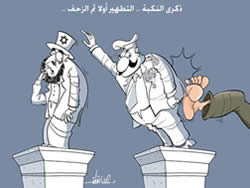
What Hamas hopes for: a domino effect in the Middle East, i.e., first toppling the Arab regimes, then Israel. The caption reads "Nakba Day – first purification and then total victory" (Hamas’ daily Felesteen, May 15, 2011).
The so-called “right of return” is a central component of Hamas’ long-range strategy. For one thing, Hamas’ demand to return the refugees to Israel would undermine a political arrangement. For another, it would eventually change Israel into a non-Jewish state, leading to the establishment of Islamist Palestinian state on all the territory of Israel.
The idea of the “right of return”, with which broad swathes of the Palestinian public agree, is regarded by Hamas as a tried and true means to sabotage any peace process, or at least to put severe limitations on those conducting such a process (i.e., Mahmoud Abbas and the Palestinian Authority). It also makes it impossible to advance a solution based on the principle of two states for two people. Thus Hamas spokesmen have made it clear that they will allow the Palestinian Authority to carry out its planned UN move in September 2011 on the condition that it does not harm the Palestinians’ so-called “rights,” at the core of which are the “right of return” and the “right of resistance [i.e., violence and terrorism].”[1]
As far as Hamas and the others who reject the right of the State of Israel to exist were concerned, the Nakba Day events were successful. They were many and large, had a propaganda impact, and included the precedent of the forceful invasion of Palestinians into Israeli territory in the Druze village of Majdal Shams, who used it as a stage to proclaim the “right of return.” In our assessment, such a “success” is liable to inspire and encourage others in the territories, the Arab countries and around the world to promote similar tactics.
The themes of the various Nakba Day events
The Gaza Strip
Nakba Day events in the Gaza Strip were relatively limited. The main incident occurred near the Erez crossing in the northern Gaza Strip on the Palestinian side, where there were violent confrontations between scores of rioters and IDF soldiers. One rioter was killed and dozens were wounded.
Senior Hamas figures gave incendiary speeches denouncing Israel and in favor of jihad and the return of the Palestinian refugees to Palestine. Hamas’ propaganda office issued a press release emphasizing that Hamas had no intention of waiving the right of “liberation” or “return,” and that it was the “right” of the Palestinians “to resist” in all possible ways (i.e., to employ violence and terrorism). The “right,” claimed the release, was given to them by international agreements and anchored in three religions (Hamas’ Palestine-info website, May 14, 2011).
The statements made were the following:
1) Ismail Haniya, head of the de facto Hamas administration, gave a sermon in the Al-Amri mosque in Gaza City for Nakba Day. He said that Nakba Day marked an important turning point, which would eventually lead to “the end of the Zionist project on the soil of Palestine.” He called the last 100 years “the century of jihad and firm stance.” The Palestinians, he said, rejected a permanent settlement of the refugees [in the Arab countries] and their expulsion [from “Palestine”], and would not accept an alternative to the “return.” “Anyone who waives the ‘right of return’ has fallen,” he said. He also said that the Palestinians “trample on the Geneva Document” because it waives the “right of return.”[2] In an appeal to the Arab states he said that the Palestinians could not “liberate Palestine” by themselves and that its “liberation” “from the sea to the river” demanded Arab economic, propaganda and military support to enable the Palestinians to stop the spread of the “cancerous occupation” (Hamas’ Al-Aqsa TV, May 15, 2011).
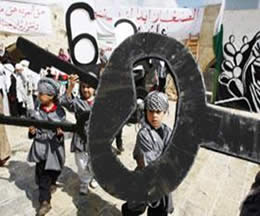
Children carry a key (symbol of the so-called "right of return") at a demonstration in the Gaza Strip. The theme of the demonstration was "We swear to carry out the dream of return" (Al-Ayam, May 16, 2011).
2) Ismail Radwan, senior Hamas figure, said at a rally near the Erez crossing, that as long as Palestinians breathed they would return to Haifa, Jerusalem, Ashqelon and the other Palestinian cities and villages. He said that the “right of return” was “a holy, historic, legitimate right” and that no one could waive it (Hamas’ Al-Aqsa TV, May 15, 2011).
3) Taher al-Nunu, spokesman for the de facto Hamas administration, said that the assemblies and gatherings held for Nakba Day in the various countries were proof that the date for the fulfillment of “the divine promise of victory, independence and the return to the houses and holy places” was approaching. He emphasized the adherence of the Hamas administration to the Palestinian principles of freedom, independence, the return of all the refugees and rejection of any kind of “alternative homeland” [for the Palestinian refugees in the Arab states in which they were currently living] (Hamas’ Palestine-info website, May 15, 2011).
4) Sami Abu Zuhri, Hamas spokesman, said that the Nakba Day events were a turning point in the history of the Arab-Israeli conflict, and proof that the Palestinians were doing their utmost to put an end to the “occupation” and realize the “right of return” regardless of the price (Hamas’ Safa News Agency, May 15, 2011).
Statements made by Hamas figures after the Nakba Day events reflected their satisfaction and the aspiration to turn the events into a model for similar actions. The Hamas propaganda bureau in Damascus issued a press release praising those who participated in the events for their “adherence to the right of return and for opening the door to a new era in the history of the struggle against Israel” (Hamas propaganda bureau website, May 15, 2011). In addition, Ismail Haniya gave a speech in which he said he predicted that “as on May 15 there were thousands, in the future there will be millions on the peaceful path to liberate Palestine…” (alresalah.net website, May 16, 2011).
The “right of return” in Fatah events in the Gaza Strip
On May 14 Fatah held a Nakba Day ceremony in Gaza City with the theme “The reconciliation [with Hamas] [is] a guarantee for the return.” More than 1,500 Palestinians attended, waving Fatah flags and pictures of Mahmoud Abbas and Yasser Arafat. Senior Fatah figure Abdullah al-Afranji, speaking for Mahmoud Abbas, gave a speech stressing the importance of the reconciliation agreement (Agence France-Presse, May 14, 2011).
Zakaria al-Agh’a, a member of Fatah’s central committee, spoke at a rally held near the Erez crossing. He said that the Palestinians would not waive the “right of return” in exchange for anything (Hamas’ Al-Aqsa TV, May 15, 2011).
Nakba Day in the Gaza Strip
Banner hung at a demonstration near Rafah, reading “The refugees are the essence of the [Palestinian] problem and the return is the solution” (Al-Jazeera TV, May 15, 2011).
Women and children at a demonstration in the Gaza Strip. The headbands read “Return.” The women hold cards with the names of villages abandoned by the refugees in 1948. The child holds a picture of a key, the symbol of the Palestinian’s desire to “return.”
Judea and Samaria
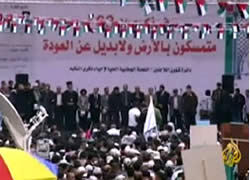
Nakba Day rally whose theme was "Adherence to the land and no substitute for return" (Al-Jazeera TV, May 15, 2011).
In general, Nakba Day events in Judea and Samaria were relatively limited in scope because they were successfully contained by the Palestinian security forces. A rally was held in Ramallah at Yasser Arafat’s grave, attended by senior Palestinian Authority figures. From there the demonstrators marched to Al-Manara Square, waving “Palestine” flags and black flags inscribed “There is no substitute for the right to return.” Nakba Day rallies were held in other locations in Judea and Samaria.
Saeb Erekat, member of the PLO’s executive committee, said Israel and the Israeli government were responsible for the turning Palestinians into refugees. He said the plan to restore 10,000 refugees a year for ten years was not a Palestinian idea but rather the idea of former Israeli Prime Minister Ehud Olmert. He claimed that Mahmoud Abbas had never mentioned any number and would not do so without consulting Jordan, Egypt and Syria (Palestinian Authority TV, May 15, 2011).[3]
Fatah spokesman Osama al-Qawasmeh, interviewed from Ramallah by the Iranian Arabic TV channel, said of the May 15 events that the various marches proved to Israel that the Palestinian refugees did not intend to waive their “right” to return to their lands, but that the opposite was true, they clung to it even more. He said the large number of participants at the events showed that “the colonialist Israeli settlement project” had failed, and that today Fatah adhered more than ever to the “right of return” (Al-Alam TV, May 16, 2011).
The Palestinian Islamic Jihad issued an announcement from Ramallah explaining the implication of agreement to the two-state solution favored by the Palestinian Authority. It meant, according to the announcement, the revoking of the “right of return” “to the territories occupied since 1948.” The “Israeli occupation,” said the announcement, had tried for years to erase the memory of the Palestinian people and to “fake the cultural history of Palestine.” For the PIJ, the extent of support for Palestine was measured according to the degree of adherence to the “right of return” (Hamas’ Palestine-info website, May 15, 2011).
The Israeli-Syrian border
The Nakba Day events went out of control in the Druze village of Majdal Shams in the northern Golan Heights. Thousands of demonstrators, most of them Palestinians, were organized and bussed in from Damascus and other locations in Syria, in our assessment with the knowledge and encouragement of the Syrian regime.
The demonstrators massed in Syrian territory across from the village of Majdal Shams. During the demonstration several hundred of them broke through the border fence unrestrained by the Syrian army. They confronted the IDF forces there and invaded Majdal Shams. Most of them returned to Syria and some were detained by Israel. Four were killed during the violent confrontation with the IDF soldiers and several dozen were wounded. More than 10 IDF soldiers were injured. The Syrian media represented the invasion as the realization of the Palestinians’ so-called “right of return.”
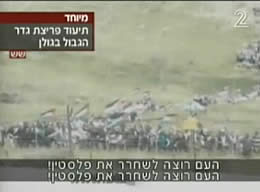
Demonstrators on the Syrian side of the Druze village of Majdal Shams shout "The people want to liberate Palestine," a slogan borrowed from the recent Arab protest movements (Photo courtesy of Israel Channel 2, May 15, 2011).
The rioters who invaded Majdal Shams gathered around the statue of the Druze leader Sultan al-Atrash, waved Palestinian and Syrian flags and shouted “Liberate the Golan Heights” and “Liberate Palestine,” and called for the return to the various places they left in 1948. Young Palestinians told the media they aspired to “return to the homeland of Palestine” and “to tell the world that the right of return is a sacred principle which will not be waived” (Haaretz, May 16, 2011).
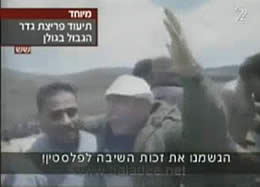
One of the demonstrators who invaded Israel: "We have realized the right of return to Palestine" (Photo courtesy of Israel Channel 2, May 15, 2011).
In one exceptional case, one of the invaders, a Syrian citizen named Hassan Hijazi, reached Jaffa where, he claimed, he found “his family’s” house. On May 15 he told Al-Arabiya TV that he was a communications engineer who belonged to a group which had organized a protest through Facebook. He said the Syrian and UN forces had not tried to prevent the demonstrators from entering Israeli because they were aware there would be casualties.[4]
The Israeli Lebanese border
In Lebanon the main Nakba Day event was held in Maroun al-Ras under the aegis of Hezbollah and with a Lebanese army presence. There were thousands of participants, most of them Palestinian, who were bussed to the site. Tents were erected for representatives of the media.
At the end of the ceremony the demonstrators marched to the Israeli-Lebanese border carrying signs calling for the “return” to “Palestine.” One of the slogans was “The people want to return to Palestine,” borrowed from the slogans of the protest movements in the Arab countries (Radio Nur, May 15, 2011). There was much media coverage of the violent confrontations which broke out between a group of demonstrators who reached the border and IDF soldiers. Ten people were killed and scores wounded (some by the Lebanese army when its soldiers opened fire in an attempt to contain the event and prevent an invasion of Israeli territory).

Left: A mob of demonstrators on their way from Maroun al-Ras to the Israeli border (Al-Jazeera TV website, May 15, 2011). Right: Rally at Maroun al-Ras before the demonstrators went to the border. (Flicker website)
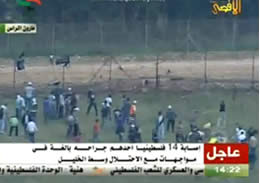
Demonstrators throw stones at IDF soldiers on the other side of the border (Hamas’ Al-Aqsa TV's website, May 15, 2011).
One of the speakers at Maroun al-Ras was Ali Barakeh, Hamas representative in Lebanon, who said the following (Al-Quds TV, May 15, 2011):
1) More than 63 years after the Nakba, the “right of return” was approaching, he said. He claimed that the “right of return” was a sacred right for both individuals and the Palestinian people as a whole, and it could not be discussed or revoked. He also called on all the citizens of Israel [whom he referred to as “settlers”] to leave their lands and return to where they came from, because they had settled on Arab land. He added that the Palestinian cause was an issue the entire Arab nation and that the “right of return” of the Palestinians was also an issue for all Arabs.
2) He appealed to the American administration, which, he said, was trying to make the “right of return” disappear and to establish the State of Israel as a Jewish state. He declared that the Palestinian people, and with it all Arabs and Muslims, supported the “right of return” and would not agree to any alternative to “Palestine.”
3) He added that the rallies in Lebanon were the Palestinian people’s way of saying they would not cede their lands or the “right of return.” He said that the demonstrations of May 15 were only the beginning of the third intifada “at home and abroad,” and that the Palestinian people would continue “popular actions” abroad and “armed resistance” [i.e., terrorism] within until all “Palestine” had been liberated and the occupation ended.
Hezbollah leader Hassan Nasrallah issued a statement praising those who demonstrated against Israel and confronted the IDF. He appealed to the demonstrators, saying that they gave “a new meaning” to Nakba Day. “…your return to your homes, fields, lands and holy places is a right, a goal…to which blood, lives and many casualties will be dedicated” (Al-Intiqad, May 16, 2011). Other Hezbollah activists said that the events of May 15 were the “return to Palestine” and “adherence to the right of return” (Al-Manar TV and Al-Intiqad, May 15, 2011).
Egypt
There were violent anti-Israeli demonstrations throughout Egypt, attended by thousands. The largest was held near the Israeli embassy in Cairo. Some broke through the blockades and reached the embassy courtyard. About 20 demonstrations were injured.
Scores of demonstrators gathered in Cairo’s Tahrir Square before leaving for Rafah. They organized a protest rally where they called for the expulsion of the Israeli ambassador to Egypt, to close the embassy and to allow the Palestinians the right to return to Palestine (Al-Yawm Al-Saba’a, May 15, 2011). The slogans included “We swear by the blood of Sheikh Yassin, we will reach you, Palestine,” “Millions of shaheeds will reach Jerusalem,” and “The people want to liberate Palestine” (Al-Yawm Al-Saba’a, May 15, 2011).
Jordan
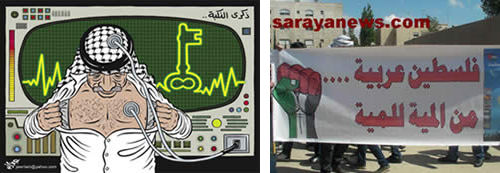
Left: The Palestinians' hearts and minds focus on the "right of return," symbolized by the key (Al-Dustour, May 16, 2011). Right: Jordanian Nakba Day poster, emphasizing the Arab nature of "Palestine"
Thousands of people participated in demonstrations near the Israeli embassy in Amman, the Jordanian capital, and in the region of the Allenby bridge near the border. The march to the bridge called itself “the march of return.” The participants carried signs reading “Return, return,” “We will redeem you, Palestine, with our lives and blood,” “Millions of shaheeds are marching to Jerusalem,” “The right of return is sacred,” “Despite you, Zion, we return, return,” etc. The demonstrators confronted the Jordanian security forces. One was killed and several dozen were wounded. Among the demonstrators were Islamist activists from Turkey, who arrived in buses. Five of them were wounded and their bus was damaged (Haksozhaber.net/news website).
Sources in the Jordanian administration expressed support for the demonstrators’ demand to realize the “right of return.” Taher al-Adwan, minister of information and spokesman for the Jordanian government, noted on his Facebook page on May 15 that Jordan strongly supported the “rights of the Palestinians,” especially the “right of return.” Ma’rouf al-Bakhit, the prime minister of Jordan, also expressed support for the “right of return” at a Nakba Day ceremony held in the Hittin refugee camp. He said that a Palestinian state established without the “right of return” and Jerusalem was not the state they desired, and would mean the direct destruction of the national Palestinian project (Jordanian News Agency, May 16, 2011).
Notes:
[1] For further information, see the May 15, 2011 article, “Radical Islamist Hamas Movement Struggles to Present a Moderate Image Since the Palestinian Reconciliation Agreement”.
[2] The Geneva Document proposes a permanent Israeli-Palestinian agreement based on the 2000 Clinton outline. One of its articles refers to mutual recognition of the Jewish people and the Palestinian people to their own states. Another article deals with a full solution to the problem of the refugees based on their transfer to the Palestinian state and reparations.
[3] The statement was made in response to a document revealed by Al-Jazeera TV as part of its exposure of documents dealing with the Israeli-Palestinian negotiations when Ehud Olmert was prime minister. In the document (the report of a meeting between the NSU and Mahmoud Abbas, March 24, 2004) Mahmoud Abbas says he is aware that a massive influx of refugees into the territory of the State of Israel would mean its end.
[4] Anwar Raja, in charge of propaganda for the Popular Front for the Liberation of Palestine – General Command (PFLP-GC, Ahmed Jibril’s organization) said that the “popular activity” had been carried out “under Syrian political aegis ” (Al-Dunya TV, May 15, 2011).



 RSS
RSS

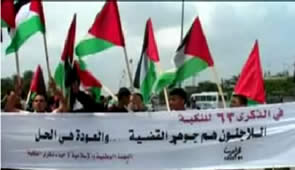

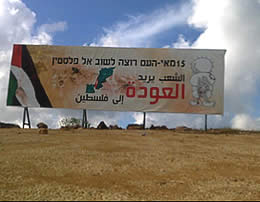
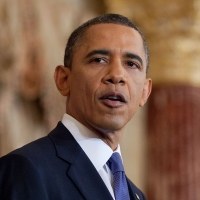

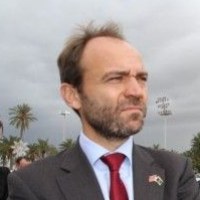
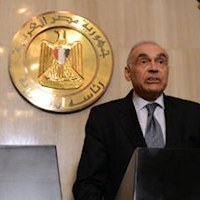





#Nakba Day: “Right of Return” is Central to Palestinian’ Strategy to Liberate “Palestine” | #Hamas #PA #Israel #lies http://j.mp/iZolTY
#Nakba Day: “Right of Return” is Central to Palestinian’ Strategy to Liberate “Palestine” | #Hamas #PA #Israel #lies http://j.mp/iZolTY